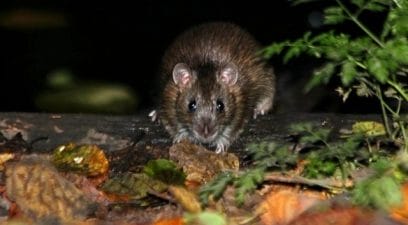The brown rat, also known as the Norway Rat or Rattus Norvegicus, is the most common species of rat found in the UK. At Pest-Tech, we often get asked about how to spot rats in the home and identify brown rats.
To help homeowners, we’ve put together this handy guide to the brown rat and what to do if you think they’ve entered your property.
Characteristics The Brown Rat
The brown rat (Rattus norvegicus), also known as the Norway rat, is a small mammal with a thick body about 8 inches long. Its colour may vary from different shades of grey to brown, with a lighter underside. It has a blunt nose and muzzle, and its ears are close to the body. Its eyes are small, and the tail is shorter than the head and body.
If you’ve ever seen a rat in a pet shop or in a cage at someone’s home, you’ll recognise the facial features of the brown rat instantly. That’s because pet rats, or fancy rats as they’re known, are domesticated brown rats that have evolved to produce more colours.
Because it needs to stay camouflaged and hide from predators, the wild brown rat has retained its signature brown fur. Its domesticated cousins can come in a range of colours, but they have the same small, narrow heads and beady black eyes that all brown rats have.
Many homeowners mistake rats for mice, but although they are related, the two are vastly different species. The main visual differences between brown rats and mice are size and tail appearance.
Brown rats are significantly bigger than mice and have short, thick, completely hairless tails. This sets brown rats apart from mice, as they have long hairy tails.
So, if you ever see a rodent pest with a hairless tail and brown fur, you’ve probably encountered a brown rat.
How Do I Know I Have Brown Rats?
The most obvious sign of a brown rat infestation is the presence of living rats, both by sight or hearing, in the roof space or walls. Rats are secretive and nocturnal, so if live rats are observed in plain sight, it is likely that you’ve got a major infestation. That’s because when space becomes limited due to increased population, rats are forced out into the open. This is also the case when there is a large population and the rats are competing for food sources.
Brown rats live in burrows found in embankments, beneath the roots of trees, under sheds and decking and in many other places that make them feel secure. In the home, their nests may also be found inside in lofts, attics, beneath floorboards, inside wall cavities and in other dark, infrequently visited locations. Find out more about how to identify a rat’s nest in our guide.
Because their teeth grow constantly, rats gnaw on materials such as wood, brick and plastic. This helps them to keep their teeth down and also create escape routes. The presence of holes and damage in floorboards and walls are clear signs of infestation. Rat teeth marks are large and rough in appearance, so check any furniture or structural features for these marks regularly.
Another clear sign of rats is the presence of rat droppings. Brown rat droppings are 1-2 cm in length and have a tapered end. They are usually a dark brown colour and can be found in clusters throughout infested properties.
In the event of an infestation, it is recommended to use the services of a qualified pest controller. Once they have invaded the home, they are very difficult to get rid of, but professionals can remove the rats and block up entry points to ensure they don’t come back.
Other Species Of Rat You Might Notice
In the UK, the rat population is made up of two main species: the brown rat, which we’ve already mentioned, and the black rat.
Black rats are both rarer and smaller than brown rats and tend to live in rural areas near bodies of water, such as rivers. Black rats also have a pointer face than brown rats, so they can easily be mistaken for voles.
Many people call the brown rat “the common rat”, which shows how much more likely you are to see one than you are a black rat. Still, if you think you have either in your home, you need to be proactive.
How to Deal With a Rat Infestation
There are many different ways to deal with a rat infestation and plenty of DIY rat control products on the market. Unfortunately, many of these solutions aren’t effective in removing rats, which may have built up an immunity to certain poisons. If the poison is easily accessible, it could become a danger to pets, local wildlife and even children.
Additionally, rats tend to be wary of unknown objects in their established routes; this is known as neophobia, or the fear of unknown objects, and it can render many traps ineffective.
Therefore, the best way to get rid of brown rats is to work with local pest control providers like us. We are RSPH level-2 certified and have access to professional-grade products that allow us to effectively remove rats from your property.
So, if you think you’ve got brown rats or any rodent pests in your Maidstone home, you need professional rat control. Contact Pest-Tech by calling 01622 296055 to find out how we can get rid of your brown rat infestation for good.

